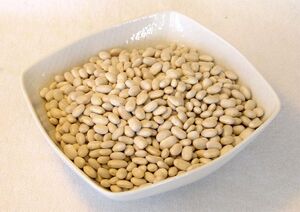Fassolia Gigantes Elefantes Kato Nevrokopiou Φασόλια γίγαντες ελέφαντες Κάτω Νευροκοπίου (Kato Nevrokopi giant elephant bean)

PGE/ΠΓΕ Fassolia Gigantes Elefantes Kato Nevrokopiou Φασόλια γίγαντες ελέφαντες Κάτω Νευροκοπίου (Phaseolus coccineus or multiflorus) is a large, kidney shaped bean from Greece. 1000 seeds weigh at least 1200g. They must satisfy all the requirements of the packaging specifications for edible local prepacked dried legumes.
Geographical area: In Drama prefecture giant elephant beans are grown in the Kato Nevrokopi basin and especially in the rural parts of the municipalities of Kato Nevrokopi, Chrysokephali, Levkogia, Exochi, Dasota, Vathytopos, Kataphyto, Kato Vrondos, Perithorio, Ochyro, Achladia, Pagoneri, Mikroklisoura, Potami and Mikromilia. These areas are contiguous.
Proof of origin: This type of bean is grown exclusively in the traditional manner in the abovementioned parts of the Kato Nevrokopi basin in Drama prefecture.
Method of production: The beans are grown in the open.
Link: This type of bean is grown in the traditional manner in the Kato Nevrokopi basin in Drama prefecture, where it is packed and marketed. The product is of excellent quality, thanks to the areas's microclimate and to the limestonefree soil. It is well known on the domestic market.
Gastronomy: PGE/ΠΓΕ Fassolia Gigantes Elefantes Kato Nevrokopiou Φασόλια γίγαντες ελέφαντες Κάτω Νευροκοπίου should be kept in a clean place under good hygienic conditions, without particular care, given the product's resistance. They are consumed cooked, baked or boiled, seasoned with oil and served with other vegetable products such as onions, tomatoes, celery and carrots.
Reference: The European Commission
#bean #vegetable #carrots #greece #beans #celery #legumes #vegetables #seeds #kidney #onions